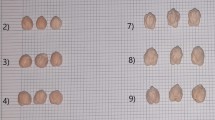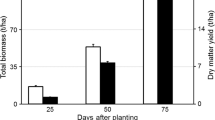Abstract
Kenaf is an economically important crop that contains various functional compounds. The objective of this study was to evaluate the nutritional properties of leaves, stem bark, flowers, and seeds collected from three mutant kenaf cultivars (Jangdae, Baekma, and Jeokbong) and two original cultivars (Jinju and C14). For all analyzed tissues, there were no significant differences in the proximate compositions (moisture, crude protein, crude fiber, crude fat, ash, and nitrogen-free extract) among the tested genotypes, except for the leaf crude protein content, which was highest in Jinju plants. Of the tested minerals, potassium and calcium were the most abundant in all tissues. Additionally, we detected significant differences in the mineral contents (e.g., calcium, phosphorus, potassium, magnesium, zinc, and iron) of various tissues in all cultivars. Proline and phenylalanine were the major amino acids detected in leaves, and the highest total amino acid (TAA) and essential amino acid (EAA) contents were observed in Jinju plants. The TAA and EAA contents were lower in stem bark than in the other tissues, except in Baekma plants, in which the lowest levels were observed in flowers. Moreover, the TAA and EAA contents were approximately 20 times lower in white flowers (Baekma) than in ivory flowers. Furthermore, the highest TAA and EAA concentrations were observed in Jangdae seeds. These results may be useful for identifying the optimal cultivar and tissues for use in food products.
Similar content being viewed by others
References
Alexopoulou E, Papattheohari Y, Christou M, Monti A. 2013. Keanf: A Multi-purpose Crop for Sever Industrial Applications, Springer-Verlag, London, UK pp. 1–15
AOAC. 1990. Official Methods of Analyses, 15th edition. Association of Official Analytical Chemists. Washington, DC, USA
AOAC. 1995. Official Methods of Analyses, 16th edition. Association of Official Analytical Chemists. Washington, DC, USA
Bae CH, Lyu JI, Sarantuya G, Chai JS, Kim JH, Yang TG, Lee MY, Yang DC. 2005. Effects of proton beam irradiation on germination and growth of tobacco and rice. Korean J. Plant Res. 18(3): 462–469
Bellisle F. 1999. Glutamate and the UMAMI taste: sensory, metabolic, nutritional and behavioural considerations. A review of the literature published in the last 10 years. Neurosci. Biobehav. Rev. 23: 423–438
Broderick GA, Walgenbach RP, Maignan S. 2001. Production of lactating dairy cows fed alfalfa or red clover silage at equal dry matter or crude protein contents in the diet1. J. Dairy Sci. 84: 1728–1737
Carlotti ME, Gallarate M, Gasco MR, Morel S, Serafino A, Ugazio E. 1997. Synergistic action of vitamin C and amino acids on vitamin E in inhibition of the lipoperoxidation of linoleic acid in disperse systems. Int. J. Pharm. 155: 251–261
Dempsey JM. 1975. Fiber crops. The University Presses of Florida, Gainesville, USA
Frazier WC, Westhoff DC. 2007. Food microbiology 4th ed. Tata McGraw-Hill Publishing Co. Ltd., New Delhi, India
Fu HY, Shieh DE, Ho CT. 2002. Antioxidant and free radical scavenging activities of edible mushrooms. J. Food Lipids 9: 35–43
Gilani GS, Xiao C, Lee N. 2008. Need for accurate and standardized determination of amino acids and bioactive peptides for evaluating protein quality and potential health effects of foods and dietary supplements. J. AOAC Int. 91: 894–900
Gomes MH, Rosa E. 2001. Free amino acid composition in primary and secondary inflorescences of 11 broccoli (Brassica oleracea var italica) cultivars and its variation between growing seasons. J. Sci. Food Agric. 81: 295–299
Hossain MD, Hanafi MM, Jol H, Jamal T. 2011. Dry matter and nutrient partitioning of kenaf ('Hibiscus cannabinus' L.) varieties grown on sandy bris soil. Aust. J. Crop Sci. 5: 654
Jin CW, Ghimeray AK, Wang L, Xu ML, Piao JP, Cho DH. 2013. Far infrared assisted kenaf leaf tea preparation and its effect on phenolic compounds, antioxidant and ACE inhibitory activity. J. Med. Plants Res. 7: 1121–1128
Kang SY, Kwon SJ, Jeong SW, Kim JB, Kim SH, Ryu J. 2016. An improved kenaf cultivar ‘Jangdae’ with seed harvesting in Korea. Kor. J. Breed. Sci. 48: 349–354
Khare CP. 2008. Indian medicinal plants: an illustrated dictionary. Springer Science & Business Media
Kim BW, Sung KI, Nejad JG, Shin JS. 2012. Nutritive value and fermentation quality of the silage of three kenaf (Hibiscus cannabinas L.) cultivars at three different growth stages. J. Kor. Soc. Grassl. Forage Sci. 32: 353–360
Kretchmer N, Zimmermann M. 1997. Developmental nutrition. Boston: Allyn and Bacon, Boston, USA
Kubmarawa D, Magomya AM. 2009. Proximate composition and amino acid profile of two non-conventional leafy vegetables (Hibiscus cannabinus and Haematostaphis barteri). Afr. J. Food Sci. 3: 233–236
Maisarah AM, Asmah R, Fauziah O. 2014. Proximate analysis, antioxidant and antiproliferative activities of different parts of Carica papaya. J. Nutr. Food Sci. 4: 1–7
Millward DJ, Layman DK, Tomé D, Schaafsma G. 2008. Protein quality assessment: impact of expanding understanding of protein and amino acid needs for optimal health. Am. J. Clin. Nutr. 87: 1576S–1581S
Oladosu Y, Rafii MY, Abdullah N, Hussin G, Ramli A, Rahim HA, Miah G, Usman M. 2016. Principle and application of plant mutagenesis in crop improvement: a review. Biotechnol. Biotechnol. Equip. 30: 1–16
Park JS. 2016. Amino acid content in Rhododendron schlippenbachii Maxim. Flowers of different colors. Biosci. Biotech. Res. Asia 13: 1285–1289
Phillips WA, Fitch GQ, McCollum FT, Adams RS, Hartnell G. 1999. Kenaf dry matter production, chemical composition, and in situ disappearance when harvested at different intervals. Prof. Anim. Sci. 15: 34–39
Ryu J, Ha BK, Kim DS, Kim JB, Kim SH, Kang SY. 2013. Assessment of growth and seed oil composition of kenaf (Hibiscus cannabinus L.) germplasm. J. Crop Sci. Biotechnol. 16: 297–302
Ryu J, Kwon SJ, Ahn JW, Ha BK, Jeong SW, Im SB, Kim JB, Kim SH, Lee YK, Kang SY. 2016. Evaluation of nutritive value and identification of fungi in silage from new kenaf (Hibiscus cannabinus) cultivars. Int. J. Agric. Biol. 18: 1159–1168
Ryu J, Kwon SJ, Ahn JW, Jo YD, Kim SH, Jeong SW, Lee MK, Kim JB, Kang SY. 2017. Phytochemicals and antioxidant activity in the kenaf plant (Hibiscus cannabinus L.). J. Plant Biotechnol. 44: 191–202
Shagal MH, Kubmarawa D, Ndahi JA, Samson PE. 2014. Amino acid profile of Hibiscus sabdariffa. J. Chem. Biol. Phys. Sci. 4: 2310–2319
Shaheen MA, El-Nakhlawy FS, Al-Shareef AR. 2012. Roselle (Hibiscus sabdariffa L.) seeds as unconventional nutritional source. Afr. J. Biotechnol. 11: 9821–9824
Shu QY, Forster BP, Nakagawa H. 2012. Plant Mutation Breeding and Biotechnology. Plant Breeding and Genetics Section, Joint FAO/IAEA Division of Nuclear Techniques in Food and Agriculture, International Atomic Energy Agency, Vienna, Austria pp. 21–30
Verma KS, Kaushal VS. 2014. Nutritive assessment of different plant parts of Carica papaya Linn of Jabalpur region. J. Nat. Prod. Plant Resour. 4: 52–56
Webber III CL, Bledsoe VK. 2002. Plant maturity and kenaf yield components. Ind. Crops Prod. 16: 81–88
Whitney EN, Rolfes SR. 2005. Understanding Nutrition. 10th Edition. Thomspn / Wadsworth Publishing Company, Belnont, CA pp. 132–139
Yu H, Yu C. 2007. Study on microbe retting of kenaf fiber. Enzyme Microb. Technol. 40: 1806–180
Author information
Authors and Affiliations
Corresponding author
Rights and permissions
About this article
Cite this article
Kim, DG., Ryu, J., Lee, MK. et al. Nutritional Properties of Various Tissues from New Kenaf Cultivars. J. Crop Sci. Biotechnol. 21, 229–239 (2018). https://doi.org/10.1007/s12892-018-0039-0
Received:
Revised:
Accepted:
Published:
Issue Date:
DOI: https://doi.org/10.1007/s12892-018-0039-0




